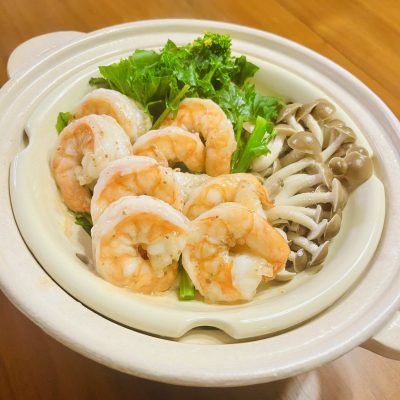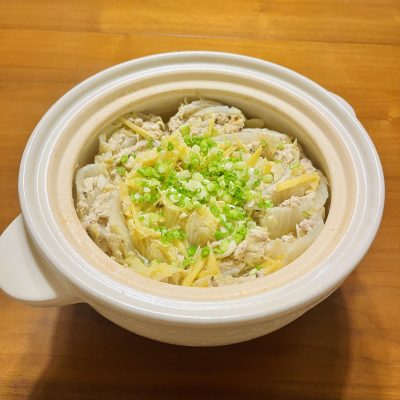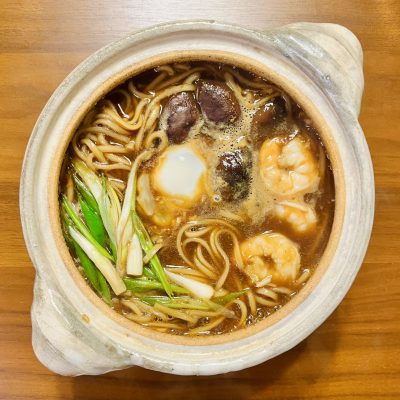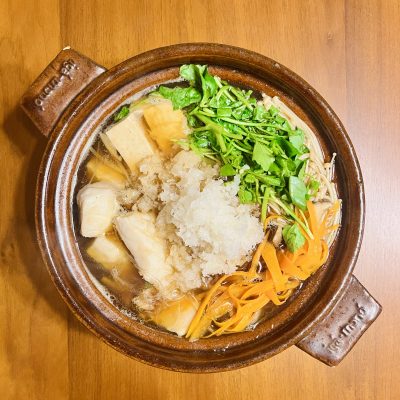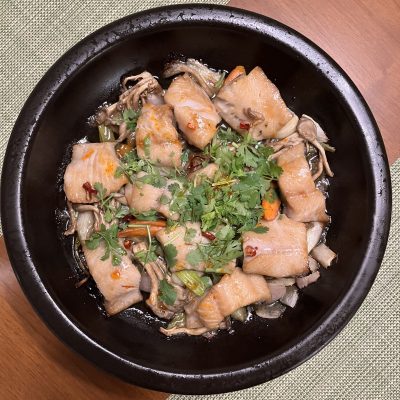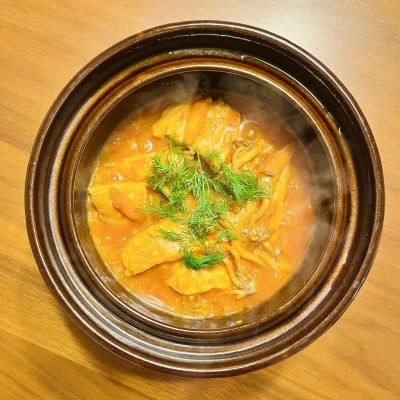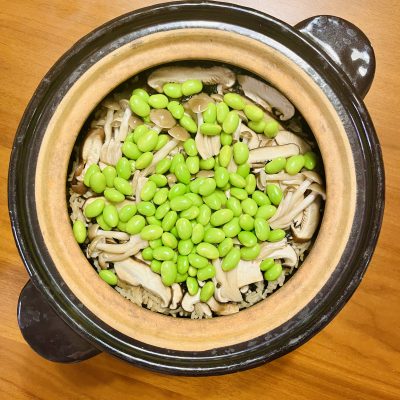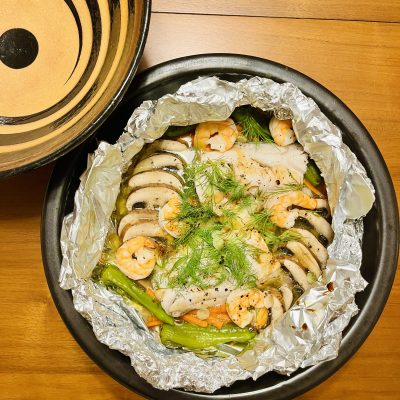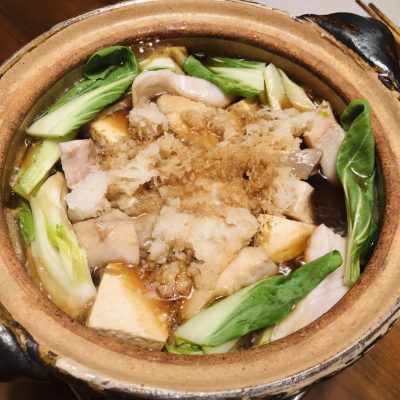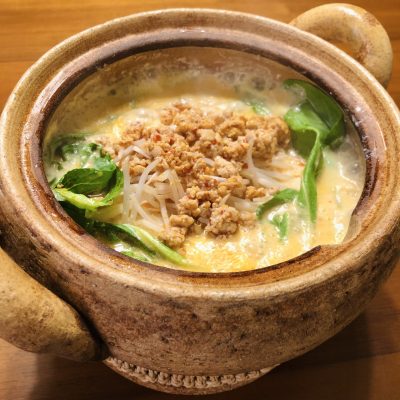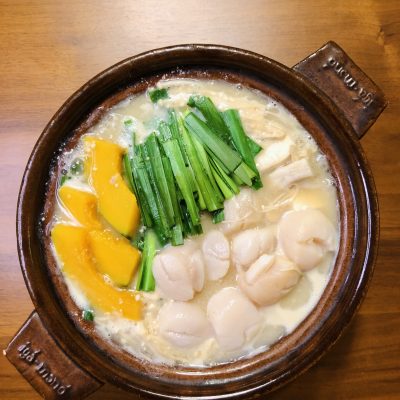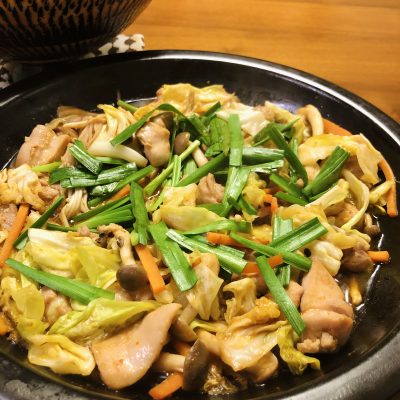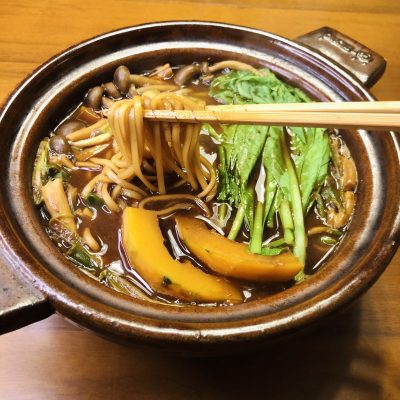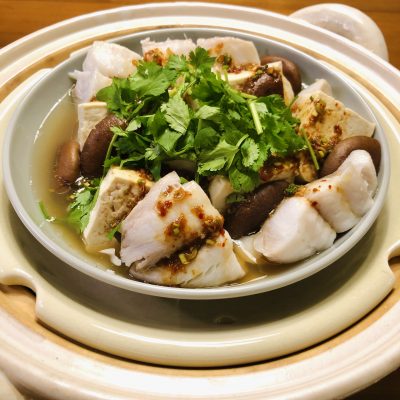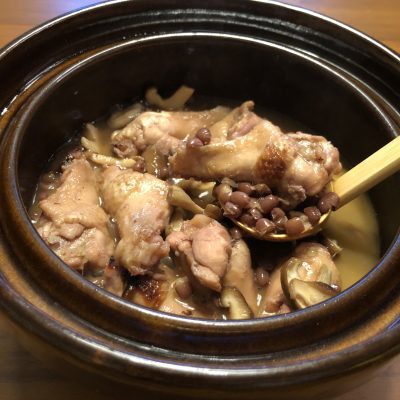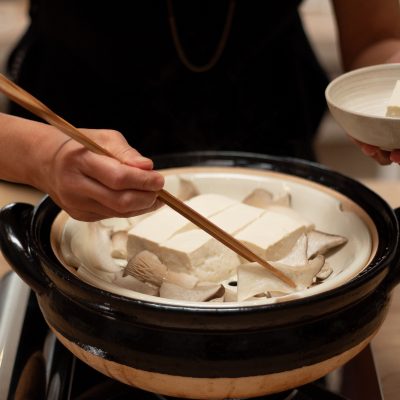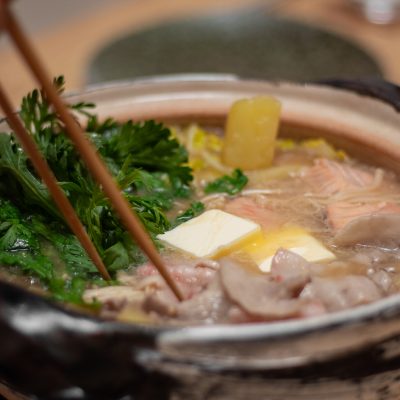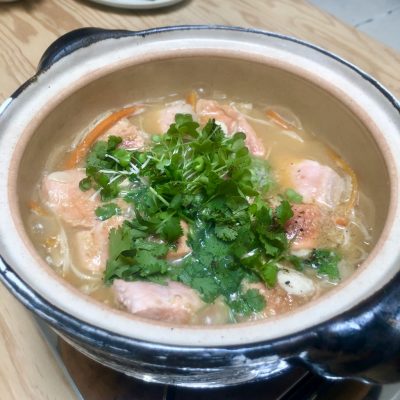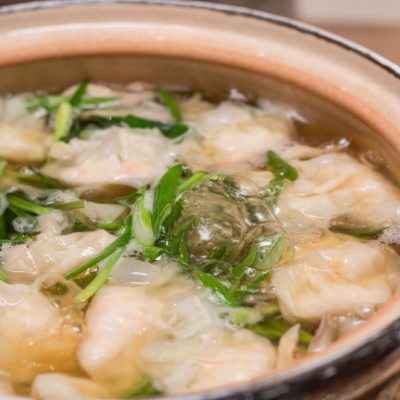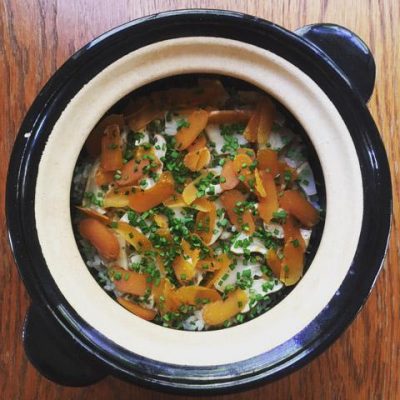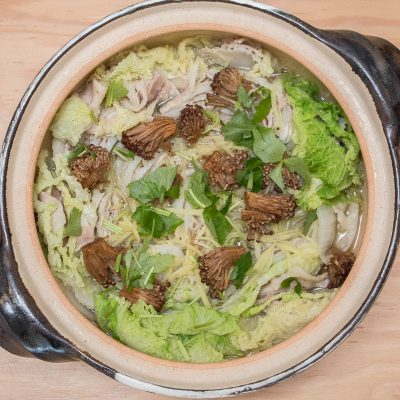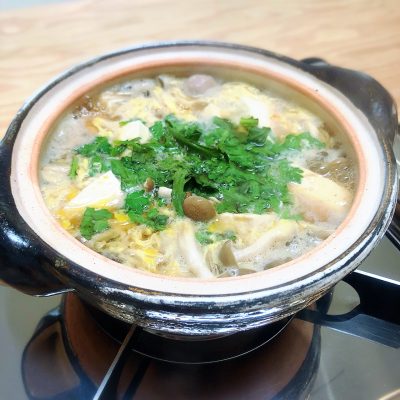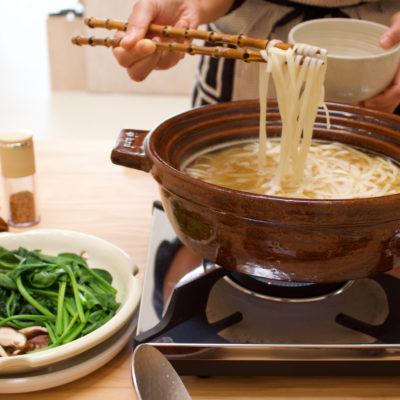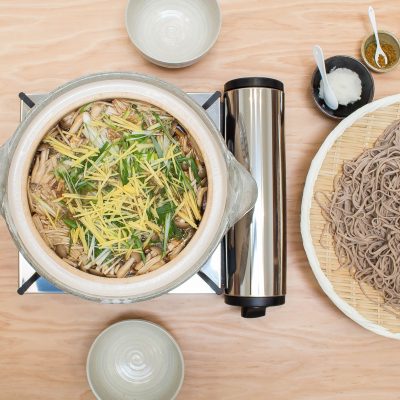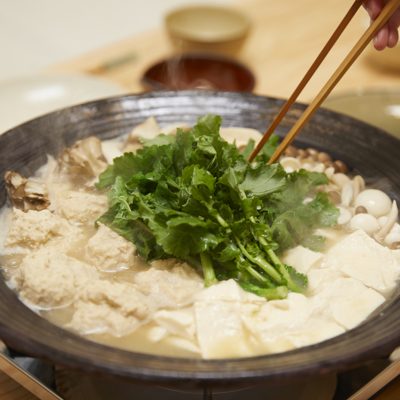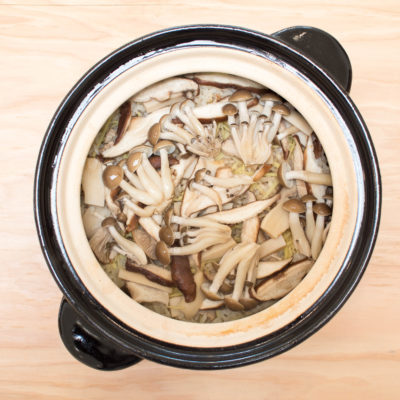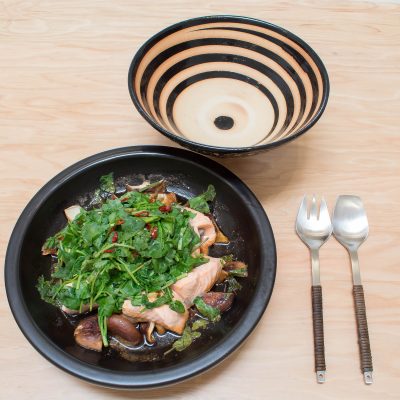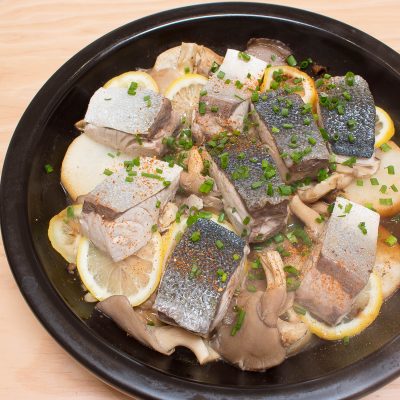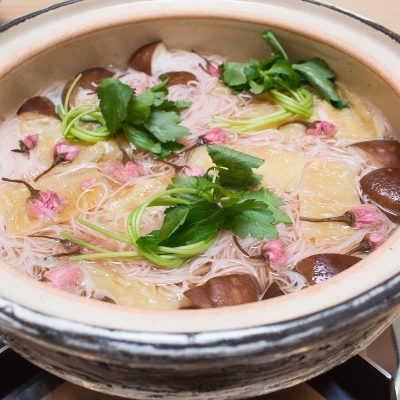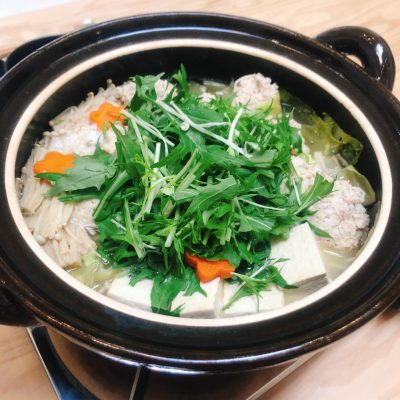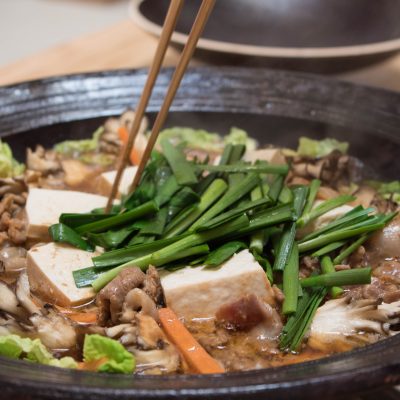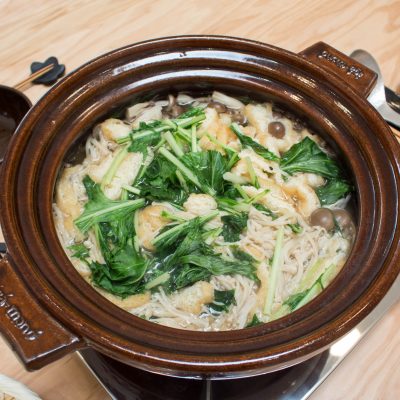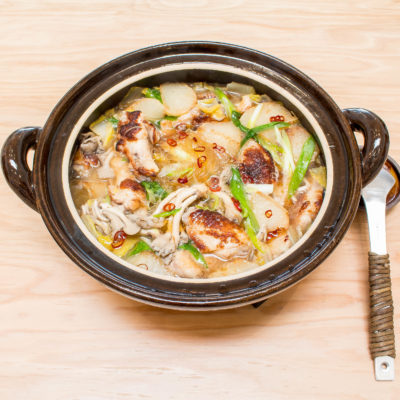Simple donabe steamed shrimp and rapini is almost a non-recipe dish and always delightful. I like to serve with my homemade Yuzu Ponzu (recipe in my DONABE Cookbook). If you opt for a ready-made ponzu, we have great ones in our pantry section, too. Sansho and sake enhances the flavor and sansho adds the nice subtle citrusy kick. The addition of katakuriko (potato starch), although it’s optional, seals the flavors and the helps the texture to be so plump.
Tag Archives: Mushroom
Chicken & Tofu Mille Feuille Nabe
Here is a new variation to my “mille feuille” nabe recipes and this is a total keeper. It’s napa cabbage with ground chicken and tofu filling and tastes so rich and soothing. I season the dish with a Vegetable Dashi bag by simply tearing the bag and sprinkle the contents over the dish before cooking. This vegetable dashi bag is so convenient and the result is simply fantastic. The dish is packed with umami and already so tasty on its own, but I like to drizzle a small amount of soy sauce or a dab of Yuzu-Kosho.
Shrimp Miso Udon
Perfect for a cold season, this is Shrimp and Udon, Simmered in Dark Miso Broth. There is something about the deep simmering sound and look of the donabe noodles in miso broth. I make this dish repeatedly in the cold season. It’s a brilliant single serving one pot donabe meal which has rich satisfying flavors and keeps my body warm so nicely. I like to coat the shrimp in katakuriko (potato starch – you can omit or substitute with corn starch), as it helps shrimp turn really nice plump texture and also lightly thickens the broth. Also, shrimp cooks fast and adds nice flavors to the broth, but you’re welcome to omit or replace with your choice of topping.
Halibut & Daikon Hot Pot
Here’s my healthy seafood hot pot, Halibut Mizore Nabe – Halibut (or your choice of fish) is quickly simmered with vegetables and finished with a generous amount of grated daikon on top. With the addition of the glass noodles, this dish makes a very satisfying one pot donabe meal.
Garlic Black Cod
Super simple and super good. I’ve been making this dish in different kinds of donabe and the dish is always a great success. It’s a sizzling dish of generous amount of garlic etc. and oyster sauce marinated black cod, finished in the oven. Minimum effort is required to execute the dish, so it’s a perfect dish to cook for your guests at a dinner party. And everybody loves it!
The tagine-style donabe , Fukkura-san, with its flat skillet bottom, cooks the ingredients most effectively. Or, you can also use other kinds of donabe (dry-heating capable is preferred), too. For a small serving, I also like to use my compact one-handle donabe , Izakaya Nabe. Happy Donabe Life!
Salmon Stew in Sake Miso Tomato Sauce
This quick donabe dish is packed with umami. The combination of the miso, tomato paste and sake brings rich and aromatic flavors, and kanzuri adds the nice spicy nuance (you can make it without kanzuri if you want it to be more mild). This sauce is very versatile, so you can use it for other protein, etc. The thick-body and compact Roast Donabe is my choice of donabe for this dish (and see how the contents continue to simmer a while after it’s brought to a table) but classic-style donabe or any other donabe with enough capacity can work also.
Sea Bream Rice
One of my favorite dishes to eat during the spring is Tai Meshi (Sea Bream Rice), made in a donabe. I cook the rice with a whole Tai (sea bream), so it’s not only very flavorful but the dish is perfect for festivity. I usually cook this dish with my double-lid donabe rice cooker, Kamdo-san, but since the fish I got this time was much bigger than my 3 rice-cup size Kamado-san, I decided to make it in my large-size donabe (I used my donabe steamer, Mushi Nabe, without the steam grate). By bending its tail, I could barely fit it in my donabe! To garnish, kinome (sansho leaves) are typically used in Japan. But since it’s hard to find kinome here in LA, I used dill and it paired with the rice beautifully.
Steamed Pork and Cabbage Shabu Shabu
This steamed donabe dish is so tasty and nourishing. The thinly-sliced pork and cabbage always make a great flavor combination. The ingredients are simply steamed in a donabe steamer, Mushi Nabe for 4 – 5 minutes and served with pre-prepared ponzu and garlic miso dipping sauces. Feel free to substitute any ingredients to steam and enjoy!
Mixed Mushroom and Hijiki Rice
This is one of my regular donabe rice dishes. Mixed mushrooms, hijiki, and edamame – I love the combination of these flavors when they are mixed with rice. I use kombu and shiitake mushroom dashi, so this is a vegan dish but feel free to use your choice of dashi, stock or even just water. The dish come out aromatic and so satisfying every time.
Baked Foil-Wrapped Seafood
Foil-baked seafood is such an easy-prepping and delicious dish. It also requires basically no cleaning of the cooking equipment. I always make it in my tagine-style donabe , Fukkura-san, as not only it distributes the heat perfectly without getting the bottom burned quickly but also it makes a very nice presentation at the table. The dish is flavored simply with sake, butter, and a drizzle of soy sauce and it’s so perfect! When the foil is gently cut open and the dish is revealed, it brings so much excitement, and also the aroma of butter-sake infused ingredients is so irresistible. Smoked soy sauce makes the dish so special but a regular soy sauce can work just fine, too.
Black Cod Sukiyaki with Grated Daikon
Okisuki is basically a seafood sukiyaki dish (“Oki” means ocean and “Suki” is short for Sukiyaki), and I love making this dish with black cod, as the buttery texture and rich flavor of this fish goes so well with the sauce. But, feel free to substitute fish or any other ingredients with your choice of seafood and/ or vegetables. Making this dish is as simple as just piling up the ingredients, pour the sauce, and let them cook in the donabe. It’s so tasty! If you can save the broth after enjoying all the ingredients cooked in it, you can add udon or ramen noodles to make the “shime” (finishing) course.
Soymilk Tan Tan Nabe
Tan Tan Nabe, or Chinese-inspired miso-sesame broth with ground meat donabe hot pot is one of the most popular dishes from my DONABE Cookbook. Here is another variation of Tan Tan Nabe and it’s Soymilk Tan Tan Nabe. The soymilk adds the extra richness to the flavor of this dish, while the dish is quite healthy. The broth is so flavorful and soothing with a spicy kick. Also, it’s so easy to make. So, I love making this dish so much.
Scallop Hot Pot in Miso Broth
I love scallops so much and usually get large-size sashimi grade scallops to eat in so many different ways. One of the regular dishes is this simple miso-based hot pot in a donabe. It’s made so quickly, and the scallops release so much flavors to make the broth taste so rich and wonderful. I like blending two kinds of miso (both available at TOIRO) for extra complexity.
Sizzling Shoyu Chicken & Cabbage
Kei-chan is a very popular local dish from Gifu, Japan. In my past visits to Gifu, I was really fascinated by this homy chicken dish. The main ingredients are chicken and cabbage, and they are sit-fried together in either miso or soy-based sauce. I especially love the soy-based version, so I now have my own version and it’s so good. Because it’s stir-fried, tagine-style donabe works especially great with its flat skillet bottom. But, you can also improvise the dish with other types of donabe which can be heated empty.
Hatcho Miso Udon Hot Pot
This dish can be made so quickly and create a balanced one-pot meal. I love the deep flavor of hatcho miso which is a dark miso. The flavor is almost chocolaty. Once the udon noodles are par-cooked, all the ingredients are cooked in one donabe. I like vegetables and tofu in this dish, so this dish is completely vegan. But, if you like, you can also enjoy this dish with an addition of meat. Chicken or duck slices are particularly good.
Steamed Black Cod with Soy-Negi Sauce
My large donabe steamer, Mushi Nabe, works so hard all year round. Among my favorite preparations with this donabe is a steamed fish dish. This is Steamed Black Cod with Soy-Negi Sauce. I layered black cod with tofu and shiitake mushrooms in a bowl and steamed in the donabe steamer, and poured this aromatic soy & scallion sauce (with a great kick with la-yu oil) over it to enjoy. This dish takes little effort and is really flavorful,and it also keeps your body so warm. Feel free to substitute with different kinds of fish.
Azuki Chicken
I grew up eating Azuki (or adzuki) beans and love them in both sweet and savory dishes. They cook fast and very versatile. Here is my Azuki Chicken – extremely simple stew of these two main ingredients. This humble dish is so tasty and always warms my heart. When it’s cooked in donabe, the ingredients come out so tender and flavors become so deep. While any donabe with enough capacity can cook this dish wonderfully, I especially love using my Roast Donabe. This cute compact donabe has an extra thick body with a sturdy flat lid (with no vent) that helps create optimum insulation and moisture retention. And, as the name suggests, this donabe is great for roasting as this can be heated with no liquid inside.
Ginger Amazake Hot Pot
Ginger Amazake Nabe – a healthy and delicious donabe hot pot recipe and it’s one of my favorite hot pot dishes of the season to bring comfort and keep me warm! Hope you get to try it home. Feel free to substitute chicken with just vegetables or seafood, to make it your own way.
Steamed Tofu & Mushrooms with Black Sesame Sauce
It feels like I have been making this dish all the time. It’s something I can make without even thinking and love it every time. Yes, it’s really the simplest dish you can think of. Just steamed tofu and mushrooms in a donabe steamer, Mushi Nabe. At the same time, this dish really showcases how a simple ingredients can taste so good when cooked in Mushi Nabe and makes me re-appreciate the beauty of minimalism.
I like to serve it with my Black Sesame Sauce, but they can obviously go well with many other types of sauce/ condiments, including ponzu, sea salt & sesame oil, etc.
Miso Butter Hot Pot with Salmon and Pork
I’ve made this hot pot many times this season, both for myself and many other people. And, many of them asked me to share the recipe so they can make it home. The miso broth has two kinds of miso for complexity. The addition of butter at the end gives the beautiful depth in flavor.
Ishikari Nabe is originally a regional dish from Hokkaido (the northern island of Japan), and to me, the must “rule” to be called Ishikari Nabe is that the dish has to have salmon and potato in the miso broth. They taste so good together (especially with the butter added at the end)! That being said, the broth can go well with just about anything, so you can change around the ingredients to cook in it. When I cook for my vegan friends, I use kombu and shiitake dashi, and make it with tofu and different kinds of mushrooms (and no butter).
You can make the miso base (mixture of the miso, sake, mirin and soy sauce) in advance, and when it’s ready to serve, you can simply combine the miso base with dashi, and start cooking the ingredients in it at the table (or at in the kitchen stove and serve at the table).
For “shime” (finishing course), I love making ojiya (soupy porridge) in the remaining broth. Ramen is also great, too.
Salmon and Daikon in Garlic Butter Miso Sauce
Garlic, miso, and butter…they make a brilliant combination of flavors. The main ingredients to cook in the sauce are salmon (or you can use your choice of high quality rich flavor fish) and daikon, and they are piled up with a few other ingredients and quickly simmered in the sauce. The dish has a nice rich flavor with refreshing accent with the yuzu juice. I used cilantro and daikon sprouts as a garnish for this recipe, but dill is also a nice alternative.
Shrimp Wonton Hot Pot
This recipe is always popular among friends, and I often involve my guests in the wonton making. Everybody makes her/ his own shape of wontons. They are easy to shape and fun to do. My shrimp wontons don’t contain ground meat (such as pork or chicken), so you can really enjoy the natural sweet flavors of the shrimp and its bouncy texture.
I introduce two kinds of dipping sauces for this recipe. The Yuzu & Ayu Dipping Sauce has the beautiful aroma and it’s quite light. The Sesame Dipping Sauce has the nice rich flavor. The soup is also very tasty, so you can simply enjoy this dish just with Yuzu-Kosho or Kanzuri on the side.
Tuna Hot Pot
One day, a very good customer of ours stopped by at our shop to give us a block of fresh tuna he just caught from fishing in the Pacific Ocean. How sweet of him! It was super fresh sashimi quality, so we tried some as sashimi with different kinds of soy sauces we have, then for the remaining, I decided to make a donabe hot pot with it. Tuna hot pot in donabe is a popular dish in Japan, and it’s typically made as a combination with negi (Japanese green onion). It’s called Negi-Ma Nabe. The name is short for Negi (green onion) Maguro (tuna) Nabe (hot pot).
This dish is very simple, and all you need is good quality dashi, tuna (obviously!), green onion (for the name’s sake) and any other ingredients you like to add. I like it with my ponzu.
For the shime (finishing course), I like making quick ojiya (porridge) with freshly-cooked donabe rice.
Black Cod Hot Pot in Saikyo Miso & Soymilk Broth
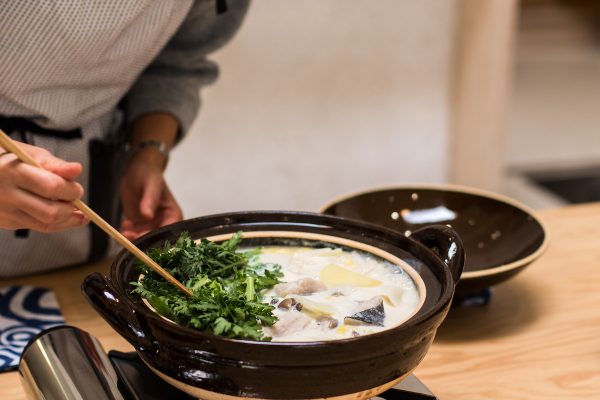
Saikyo miso is a traditional white miso from Kyoto, Japan. The color is pale and it has a natural umami-rich sweet flavor due to the higher content of koji rice (malted rice) in the miso. The sodium level is also much lower than other types of miso, so you can use a good amount of it to enjoy its rich flavor in a soup, etc. without making the dish too salty. This hot pot dish has the combination of dashi, soymilk, and Saikyo miso in the broth, so the flavor is rich and complex. Make sure to use the real Saikyo Miso from Kyoto and pure rich soymilk (with no additives) such as Banrai Soymilk.
Buttery fish like cod is perfect for this broth, other types of seafood or even chicken would certainly work in this dish, too.
Curry & Tamari Flavored Steam-Fry Vegetable Yakisoba Noodle
Enjoy this one-pot dish made with fresh yakisoba noodles and a lot of vegetables. I’ve been making this dish for years and had so many people turned on to this dish. The curry and tamari soy sauce flavors make a great combination. The noodles become nicely spicy and robust. This is a completely vegan dish with layers of flavors and textures. The sauce and sun-dried tomatoes bring out the rich umami, too.
Soba Noodle with Green Onion and Shiitake Mushroom
Soba noodle is one of the most beloved traditional Japanese foods in Japan. Many people enjoy soba dishes for lunch, and there are soba restaurants (many are hand-made) and stands everywhere in Japan. At home, soba makes a very popular meal. This is my quick soba noodle dish I love and make all the time for lunch, and I change the toppings according to what I have in my fridge or pantry. Sometimes, I serve with just mushrooms, wakame seaweed, or even completely plain with a dash of yuzu citrus zest. With the porous body of the donabe, I like that the broth stays hot until the end of the meal.
Bottarga and Matsutake Rice
When I’m lucky enough to have these special ingredients at the same time, I love making this dish. The earthy perfumy aroma of matsutake mushroom is so elegant and there is nothing equivalent to it. The umami-packed and slightly chewy character of karasumi (cured mullet roe, a Japanese delicacy, and it’s also a famous Italian ingredient, called bottarga in Italian.) You can substitute matsutake mushroom with a different kind of mushroom such as shimeji (although the aroma is very different, it’s still tasty) when matsutake is out of season. For karasumi, instead of slicing it, you can grate it to mix in the rice, too.
The dish shown in this photo is made in 1 rice-cup size Kamado-san.
Pork and Napa Cabbage Mille Feuille
This dish is all about pork and napa cabbage, cooked in a minimum way. They are simply layered to pack in a donabe, with a small amount of water and sake. There is not even dashi or salt. You can top them with some sliced ginger and mushrooms, and gently simmer for 25 – 30 minutes. The result is a tasty treat rich in umami, and it looks beautiful, too. The soup is also packed with all the natural flavors from the ingredients, so make sure to enjoy it with the dish, too.
I like to serve it with Sansho Ponzu Sauce and Hatcho Miso & Black Sesame Sauce (recipe below) for flavor variations. Or, you can simply serve it with yuzu-kosho or Kanzuri, too.
Shiso Chicken Meatball & Grated Daikon Hot Pot
This dish is packed with nutrients, and so easy to make. It’s also a great dish to enjoy with guests. Chicken meatballs have the very nice subtle shiso flavor and they become fluffy after cooked. I like adding a generous amount of coarsely grated daikon (I highly recommend you use Onioroshi daikon grater for the nice crunchy texture for grating daikon). They give both texture and more flavor to the dish.
For seasoning, I use both white tamari and soy sauce for more complex flavor (and also to keep the broth from becoming too dark), but you can use just soy sauce if you like. You can also adjust the seasoning with extra sea salt at the end. But, please remember, this dish is served with Sansho Ponzu Sauce, so the seasoning should be minimum.
Make sure to save enough broth, so you can enjoy the shime (finishing course) of soba noodles!
Chicken & Tofu Hot Pot with Egg
This is my lazy-day but feel-good quick hot pot dish. I love my small size donabe so much, as it’s so handy to use, and I can make quick one-pot-meal for 1 to 2 people in a short time. In this dish, dashi (stock) is heated with soy sauce and mirin, then chicken, tofu, and mushrooms are added one after another to cook in the broth. Once everything is cooked through, eggs are drizzled in and cooked further (I like the soft stage). I used shungiku (chrysanthemum leaves) as a topping, but you can simply use thinly-sliced green onion or any of your choice of green topping. Enjoy with some sansho powder.
Soup Udon with Steamed Vegetables
This vegan treat is so easy to make and very satisfying. You just prepare the dashi broth for the udon in the bottom bowl of the Mushi Nabe, set the steam grate on top to steam the vegetables first. Once the vegetables are ready, remove the grate and cook the udon in the broth. Because the vegetables are steamed, they tend to retain more nutrients and taste very pure. The ginger-scented broth stays also very clear and the flavor is so rich in kombu‘s umami. So, this is a win win dish. In this recipe, I used Bistro Mushi Nabe, but you can make this dish with any donabe which is equipped with a steam grate. Adjust the recipe amount according to your size of donabe.
Soba Noodle with Hot Mushroom Dipping Broth
I love making this dish especially when I am feeling a little weak and need something gentle for my stomach. Once you simmer mushrooms in a rich dashi-based broth, pour it into serving bowls and dip cold noodles in it to enjoy. The mushrooms adds the nice savory flavors to the broth. And, I love to use a generous amount of thinly-sliced ginger for both flavor and helping my body stay warm after having the dish. It’s so soothing and you can keep eating more and more. This dish is also nice to serve for a larger group. You can also change around the ingredients to cook in the broth for fun. For a vegan version, you can make with kombu dashi or vegetable dashi instead of kombu & bonito dashi.
Tofu & Spinach Hot Pot
Yu-Dofu (tofu hot pot) is a very simple and popular home dish in Japan. This version has addition of spinach and enoki mushrooms to boost nutrients and flavors. Yu-Dofu‘s best accompaniment is ponzu, and my quick daidai citrus ponzu tastes so refreshing and aromatic. Then, you can top the tofu with a generous amount of freshly-ground toasted sesame seeds in suribachi and surikogi (Japanese mortar and pestle), which is so nutty and aromatic. Kanzuri (chili condiment from Niigata, Japan) is another great condiment.
Chicken Meatball Hot Pot in Miso Broth
This simple miso-flavored hot pot is always so popular among my family and friends. By adding grated ginger and egg, the chicken meatballs becomes so fluffy and flavorful. The other main ingredients are tofu and mushrooms, which complete the dish to full satisfaction. The suggested shime (finishing course) to cook in the saved broth is udon or ramen.
Mixed Mushroom Rice
I love the earthy treat. I like to use a few kinds of mushrooms such as shiitake, king oyster, and shimeji. You can try with your choice of mushrooms. By adding sweet rice, the dish becomes nice and slightly chewy texture, but you can also make it only with short grain rice and it will taste very nice, too. For seasoning, I love white tamari, for its mellow and slightly sweet aroma, but you can substitute with usukuchi shoyu or regular soy sauce, too.
Shio-koji Salmon over Butter Sweet Potatoes
This dish is something I like to whip up especially on a busy day. While marinating the salmon in shio-koji, I I can prepare all the other ingredients, then just pile them up and let the donabe do all the work. I love the slightly caramelized sweet potato in the bottom, while the salmon is perfectly cooked medium-rare (or you can cook it longer if you like the salmon to be well-done).
Salmon, Shiitake and Watercress in Smokey Garlic Black Vinegar Sauce
With just three main ingredients (salmon, shiitake mushrooms, and watercress) and simple preparation, this sizzling dish makes a very satisfying meal. The garlic black vinegar flavor is further enhanced with smoked soy sauce, but if you don’t have it, you can make it with regular high quality soy sauce, too. Make sure to drink up any remaining sauce, or dip some freshly-cooked donabe rice, as it’s so tasty.
Steamed Halibut with Daidai Chive Sauce
Whenever I get a very fresh piece of fish, my favorite way to prepare is to make it as simple as possible to best appreciate the natural flavor of the fish. Steaming fresh-quality fish filet in donabe takes no time and it’s always a treat for me. Once you have a sauce ready, it creates a great main course. I like steaming halibut for its rich flavor and texture but it’s basically you can steam any fish of your choice. Daidai Chive Sauce is a quick sauce for which the only ingredient you need to chop is the chives. It’s full of flavor and great with steamed fish. Quick Daidai Citrus Ponzu can go well with the steamed fish, too.
Lemon Butter Yellowtail and Daikon
This dish is my unique donabe version of popular Japanese dish, buri daikon (simmered yellowtail and daikon in soy based broth). Daikon is first sautéed in butter, then, once the yellowtail is added along with the lemon and mushrooms, they were steamed with sake and Ayu Fish Sauce. All made in one donabe, and this versatile Fukkura-san donabe effectively steam-fry the ingredients. The result is so aromatic, savory, and delicious. If yellowtail is not available, this dish can be made with other rich-flavor fish such as cod or sea bass. Ayu fish sauce gives the elegantly rich umami flavor, but it can be substituted with regular soy sauce, too.
Somen Noodle and Cherry Blossoms Hot Pot
I always get so excited when the spring season comes and make a lot of cherry blossom-theme dishes. This is one of them and I add salt-preserved sakura (cherry blossom) flowers to the broth, and I even use the pink sakura-flavored somennoodles made from flour and sakura from Japan. The aroma of sakura in this dish is just so beautiful. But, don’t worry if you don’t have any of them! You can totally make the delicious somen hot pot without the sakura flavors, and this dish can be enjoyed all year round. You can also change the other ingredients to cook with the noodles by using different kinds of mushrooms or tofu, if you like. It’s so gentle on the stomach and always comforting.
Dashi-Rich Steam-Fry Hiramasa and Napa Cabbage
Simply assembled hiramasa (amberjack) with napa cabbage and shimeji mushrooms taste so pure and satisfying with the rich flavor of the dashi broth. The broth’s umami level is boosted with the addition of ayu fish sauce (I call this “magic essence”). Hiramasa can be substituted with yellowtail, sea bass, snapper, salmon, or any buttery fish filet. I like to serve this dish with plain donabe rice (white or brown).
Braised Chicken in Black Vinegar Sauce
The main ingredients of this dish are just chicken and shiitake mushrooms, yet this dish can make such a hearty meal. The meat is so succulent and falls off the bone easily even with chopsticks. The special black vinegar from Kyoto gives the umami-packed layer of flavors to this easy one-pot dish.
Egg Drop Vegetable Soup
This soup is full of flavors and very satisfying. The addition of the black vinegar gives the nice umami-rich accent to the dish. The fluffy egg with vegetables make wonderful layers of textures, too. I like to sprinkle some sansho powder to the soup for extra kick, but it’s totally optional.
Salt Butter Chanko Hot Pot
Japanese sumo wrestlers cook and eat chanko nabe at their stable every day. That’s the source of their strength. While chanko nabe refers to any types of hot pot eaten by sumo wrestlers, the most typical style is chicken as a main protein and cooked in chicken broth. It’s because chicken stands on two legs like human beings, so it is considered to bring good luck (in sumo, you lose if your hands touch the ground). Chanko nabe typically makes a very nutritious and balanced meal, as you cook a wide variety of healthy ingredients in one pot. The sumo wrestlers are big, because they eat so much of it every meal! In my version, I cook chicken meatballs and vegetables in simple salt-flavored chicken broth, and add butter cubes right before serving. The aroma is so irresistible and the flavor is superb. As a shime (finishing course), I suggest ramen noodles to cook in the remaining broth.
Spicy Pork Sesame Hot Pot
The marinade has such a rich flavor, and the creamy sesame paste makes it so aromatic. Once you have all the ingredients ready, all you need to do is just piling up the ingredients and build your excitement while waiting for the dish to cook. I love that I can taste so many different ingredients in this one dish, but you can always substitute or omit most of the ingredients as you like.
Steamed Pork Belly Shabu Shabu
It takes very little time for prepping and you can make such a satisfying complete one pot dish. If you can’t find thinly-sliced pork belly from a market, you can just buy a block and slice it into thin pieces. For a leaner choice, pork loin is also good. I like to marinade the meat in Liquid Shio-Koji for a short time because it further tenderize the meat and enhances the flavor. But, you can omit this process and the dish will still taste great. If you are cooking for a larger group, increase the recipe amount and cook multiple batches at the table!
Egg-topped Garlic Chives & Shiitake
Nira (garlic chives) and shiitake mushrooms are quickly simmered in kombu & shiitake dashi-based broth, then finished with eggs. I like the very soft and slightly runny stage of the eggs, so let it cook for a short time once the eggs are added. This dish is great as an appetizer (served as a soup), side dish, or I also like to pour over rice. If you can’t find nira, you can substitute it with spinach or pea shoot. You can also add rehydrated dry shiitake used to make the dashi for extra flavor and texture.
Mushroom & Mizuna Hot Pot
This simple vegan hot pot is so rich in flavor and satisfying. I like to slice the abura-age very thin, as these slices soak up the broth and taste like juicy noodles. If you don’t have access to abura-age, thinly-sliced tofu can work, too. The key for the rich broth flavor is to add the mushrooms before heating up the kombu-soaked water, so the mushrooms release all the umami flavors during the slow heating process. For the shime (finishing course), I like to add udon noodles to the remaining broth, but soba is also good, too.
Chicken Wings & Daikon Hot Pot
Chicken wings and daikon are a classic combination in Japanese cooking. By pan-frying these ingredients before adding to the broth, the flavor of this simple dish enhances dramatically. Because the chicken is already marinated in shio-koji, this dish doesn’t require much more seasoning. Feel free to use fingers to savor the wings, as it’s part of the fun of this dish!

